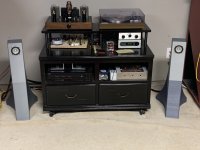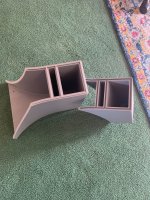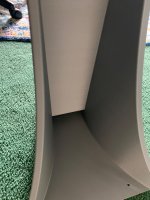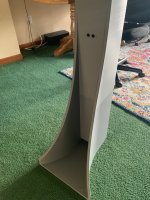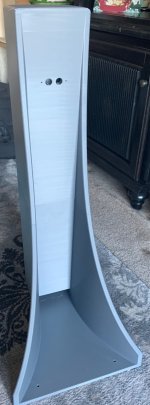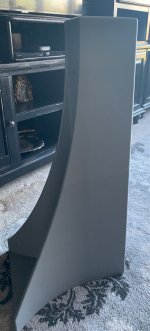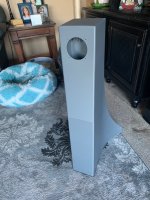This is X’s tribute/scaling of the original FH Mk3. It did push the idea that the family could be expanded. It shows a basic misunderstanding of some principals and the FH Lite we released later gets the details righ.
Scott can speak to the original story, but as i recall, when FH Lite was first shown at the Bristol show with A5,2 people kept coming back and saying thy couldn’t believe what they were hearing.
I get similar from those hearing mine with FF85wKeN.
The Frugel-Horn Family has been a successful design unlike anything we could ever have imagined.
The design came together in quite a burst. After the Frugel-Horn (the first), Scott and i worked for soe 5 years to come up with something that would be considerably better. I have the starts of many 10s of dead ends. Then the design we see today came together over a week (i can’t tell you how long the ideas were percolating in Scot’s head before i got the first version). Within 3 days Chris had a prototype and a day late rit was rejeted, nect days an iteration, 2 days later the next prototype, a couple days later and it was clear that we had a bases loaded home run. And nquickly fillowed by the public release at a VI diyFEST with a couple weeks.
Scott had distilled the growing knowledge base that has/had come from what Martinn King’s models showed in terms of the very tight ties between BLHs and TLs tied together by solid quarter-0wave theory. A careful blending of the use of the (inevitable) room, horh loading, quarter-wave support, and tricks learned from extending and objective undersanding of trciks seen implemented by the pioneers. Scott has blended and molded many tricks (Voigt, Klipsch, mass-loading, variable damping), to create a visually striking, very versatile floor standing loudspeaker that drags a huge amount of bass performance out of what would normally be considered a small single driver (nothing stoppingannyone from turing that concept into a multi-way).
We resisted growing the family, the original Frugel-Horn Mk 3 (the Mk 2 died in my Vectorworks drawings) was such a large step, and so well-suied in size to the alignment we had to be pushed to expand, first the largwe Frugel-Horn XL, then Frugel-Horn Lite (X’s done right), and finally Joan (a slightly different alignment to keep the size down). Few believe a Lite can do what it does, and Joan is just getting off the ground. FHXL is probably the most popular, often populated by MA A10.3/10, now CHP/CHR-90/P11/A11ms, Fostex FF165wk).
One of the most memorable occurrences was when Mark Fenlon heard one of the first FHXL prototypes with A10PeN upstairs at Chris’. The look on his face, the can you play that again, i don’t beleive what i adhering….
Given the number pof know flat-paks sold probably over 10k pairs of members of the FH family exist.
A loudspeaker that is a pretty safe bet, and helpbringing manufacturingback from China. Cottage industry welcome.
dave
Scott can speak to the original story, but as i recall, when FH Lite was first shown at the Bristol show with A5,2 people kept coming back and saying thy couldn’t believe what they were hearing.
I get similar from those hearing mine with FF85wKeN.
The Frugel-Horn Family has been a successful design unlike anything we could ever have imagined.
The design came together in quite a burst. After the Frugel-Horn (the first), Scott and i worked for soe 5 years to come up with something that would be considerably better. I have the starts of many 10s of dead ends. Then the design we see today came together over a week (i can’t tell you how long the ideas were percolating in Scot’s head before i got the first version). Within 3 days Chris had a prototype and a day late rit was rejeted, nect days an iteration, 2 days later the next prototype, a couple days later and it was clear that we had a bases loaded home run. And nquickly fillowed by the public release at a VI diyFEST with a couple weeks.
Scott had distilled the growing knowledge base that has/had come from what Martinn King’s models showed in terms of the very tight ties between BLHs and TLs tied together by solid quarter-0wave theory. A careful blending of the use of the (inevitable) room, horh loading, quarter-wave support, and tricks learned from extending and objective undersanding of trciks seen implemented by the pioneers. Scott has blended and molded many tricks (Voigt, Klipsch, mass-loading, variable damping), to create a visually striking, very versatile floor standing loudspeaker that drags a huge amount of bass performance out of what would normally be considered a small single driver (nothing stoppingannyone from turing that concept into a multi-way).
We resisted growing the family, the original Frugel-Horn Mk 3 (the Mk 2 died in my Vectorworks drawings) was such a large step, and so well-suied in size to the alignment we had to be pushed to expand, first the largwe Frugel-Horn XL, then Frugel-Horn Lite (X’s done right), and finally Joan (a slightly different alignment to keep the size down). Few believe a Lite can do what it does, and Joan is just getting off the ground. FHXL is probably the most popular, often populated by MA A10.3/10, now CHP/CHR-90/P11/A11ms, Fostex FF165wk).
One of the most memorable occurrences was when Mark Fenlon heard one of the first FHXL prototypes with A10PeN upstairs at Chris’. The look on his face, the can you play that again, i don’t beleive what i adhering….
Given the number pof know flat-paks sold probably over 10k pairs of members of the FH family exist.
A loudspeaker that is a pretty safe bet, and helpbringing manufacturingback from China. Cottage industry welcome.
dave
Nice to hear the story of Frugel Horn family.
One becomes curious about what they can achieve. You made a strong impression on Mark
with FHXL.
One becomes curious about what they can achieve. You made a strong impression on Mark
with FHXL.
That was 12 years ago when I did this, and it was more pure enthusiasm and willingness to try stuff because foam core made it easier to build cabinets without a real workshop and it was relatively quick. Despite being the “wrong” way to go about doing this by scaling the plans down, and increasing the mouth of the horn into a larger expansion, the end result sounded pretty good and appears to be quite forgiving of the driver one installs in it. Perhaps it was just pure luck, but the freedom we have to try new things in foam core is great for experiments.
Projects from @xrk971 inspired me a lot and so I have already tried a couple of them. Now I would like to give this project a try as it can be a good cheap solution for a Christmas gift as I have plenty of foam core left as well as some ply for the front wall.
At the moment I have a sets of spare TC9FD18-08, but the Markaudio CHN-50, TG9FD10-04 and 3FE22/35 are in my scope for a while. I wouldn't like to change the speakers just for fun, but the the 4ohm impedance seems to be a better solution for the intended application (the speakers will be connected to a smaller Hi-Fi system, original speakers are rated 3 ohm). Eventually, could the TG9FD10-04 work in the horn as well? Does someone have a comparison between the glass fiber and the polymer cone drivers from Vifa? The drivers seem to be very similar (though the datasheet shows a dip in the top range for the glass-fiber drivers). Even better, does someone have a comparison of the other listed drivers for the FH3-inspired horn?
How important is to keep the opening dimensions? Could I shorten it by a bit (2 inch) so the width would be around 10 inch without a big impact on the sound? I have seen no broadening in the original Frugel Horn family designs.
Any inputs and help are more than welcome! 🙂
At the moment I have a sets of spare TC9FD18-08, but the Markaudio CHN-50, TG9FD10-04 and 3FE22/35 are in my scope for a while. I wouldn't like to change the speakers just for fun, but the the 4ohm impedance seems to be a better solution for the intended application (the speakers will be connected to a smaller Hi-Fi system, original speakers are rated 3 ohm). Eventually, could the TG9FD10-04 work in the horn as well? Does someone have a comparison between the glass fiber and the polymer cone drivers from Vifa? The drivers seem to be very similar (though the datasheet shows a dip in the top range for the glass-fiber drivers). Even better, does someone have a comparison of the other listed drivers for the FH3-inspired horn?
How important is to keep the opening dimensions? Could I shorten it by a bit (2 inch) so the width would be around 10 inch without a big impact on the sound? I have seen no broadening in the original Frugel Horn family designs.
Any inputs and help are more than welcome! 🙂
habato
Before 3~4 years I compare TG9.... to 3FE35 (I found the later in a sound laboratory here in Athens in their boxes, "sealed" ). I like better (by far) TG9... . It has better "highs" and more "details" at "lows" (above 100Hz ~ 500Hz clarinet, double bass). It is a "faster more stiff diaphragm". Of course it is my personal taste.
Elias
Before 3~4 years I compare TG9.... to 3FE35 (I found the later in a sound laboratory here in Athens in their boxes, "sealed" ). I like better (by far) TG9... . It has better "highs" and more "details" at "lows" (above 100Hz ~ 500Hz clarinet, double bass). It is a "faster more stiff diaphragm". Of course it is my personal taste.
Elias
Thank you Elias! I messed up the numbering, I meant the 3FE25, not the 35 - it was a typo as 3 does not even exist. I guess that is what you meant too? 🙂
The other questions still remain though.
Tomas
The other questions still remain though.
Tomas
It’s a very forgiving design so I think the 4ohm TG9 should work fine.Projects from @xrk971 inspired me a lot and so I have already tried a couple of them. Now I would like to give this project a try as it can be a good cheap solution for a Christmas gift as I have plenty of foam core left as well as some ply for the front wall.
At the moment I have a sets of spare TC9FD18-08, but the Markaudio CHN-50, TG9FD10-04 and 3FE22/35 are in my scope for a while. I wouldn't like to change the speakers just for fun, but the the 4ohm impedance seems to be a better solution for the intended application (the speakers will be connected to a smaller Hi-Fi system, original speakers are rated 3 ohm). Eventually, could the TG9FD10-04 work in the horn as well? Does someone have a comparison between the glass fiber and the polymer cone drivers from Vifa? The drivers seem to be very similar (though the datasheet shows a dip in the top range for the glass-fiber drivers). Even better, does someone have a comparison of the other listed drivers for the FH3-inspired horn?
How important is to keep the opening dimensions? Could I shorten it by a bit (2 inch) so the width would be around 10 inch without a big impact on the sound? I have seen no broadening in the original Frugel Horn family designs.
Any inputs and help are more than welcome! 🙂
The 3FE25 should work well also.
Thank you XRK for the reply. I think I will dig out your great Nautilus project from with a single Vifa from the box to test the amplifier with the 8 ohm load. If that doesn't works, I may give the other speaks a try.
Could you please reflect on the modification of the horn opening? Would shortening the opening (and hence narrowing to about 10") affect the sound significantly?
Could you please reflect on the modification of the horn opening? Would shortening the opening (and hence narrowing to about 10") affect the sound significantly?
I was able to 3d print these and have Fostex FF85WK in them. The back horn is a little bigger than the original XR design. I have not decided what color to finish them but been listening to them for a month or so. Listen to the video with good set of ear phones and turn it up. I hope the link works, pretty good bass for a speaker with a 3 inch driver. The amp is a type 45 SET but running type 46 globe, 1.25 watts.


Attachments
Last edited:
Hi Tiverson, if you don’t mind, please share your STL model files of the speaker here for others to give the 3D print option a try. It’s a beautiful speaker with the curved wings. Do you have any internal photos before assembly? Also, what was your print wall thickness and internal hollow void density for the walls as 15mm is quite thick.
Thanks!
Thanks!
here are the stl files per XR request, now this is for the Fostex FF85wk driver so if you try a different driver, it may not fit. i do have the model and i can put in different bolt pattern and different size opening for a different driver, but that takes a little time to do. you will need a a 3d printer with at least a 400mm x 400mm x 450mm build volume. It took the bottom half 10 days and some hours to print, you may be able to cut that down by bumping the speed print. also this is for diy for yourself and not to be sold commercial, just want to put that out there.
Attachments
Here are pictures of the two haves. The joint is tongue and grooved so they are fitted together.Hi Tiverson, if you don’t mind, please share your STL model files of the speaker here for others to give the 3D print option a try. It’s a beautiful speaker with the curved wings. Do you have any internal photos before assembly? Also, what was your print wall thickness and internal hollow void density for the walls as 15mm is quite thick.
Thanks!
Attachments
Thank you, Tiverson! Nice touch with the tongue and groove. I think a popular driver might be the TC9FD. If I recall, many 3.5in drivers have the same cutout hole circa 2.9in to 3.0in dia and a similar screw hole base diameter. The FF85WK is a bit smaller at 2.9in and TC9FD is 3.0in so would require some enlargement with a Dremel tool etc.
Your welcome XR, I want to add that theses are the speaker 5 way binding post I used for the build. Also if you do not have a 3d printer, there are companies that will print them for you but, they are pricy because of the size.
https://www.parts-express.com/Gold-Plated-Banana-5-Way-Speaker-Terminal-260-302?quantity=1
https://www.parts-express.com/Gold-Plated-Banana-5-Way-Speaker-Terminal-260-302?quantity=1
More picture of the prints before assembling. Also I tapped the m4 holes for the binding post. If anybody builds these please post picture on this thread or XR forums. Merry Christmas all!
Attachments
XR, can you get me the the spec for the tc9fd driver and I will modify the design to take that driver and post the STL files for them.
The datasheet is here but it’s not very clear what the hole diameter is based on the sheet. The info from Parts Express says the cutout hole diameter is 3.0in and that’s what I remember using. Hence, the FF85WK was compatible, being 0.1in smaller.
https://www.parts-express.com/pedocs/specs/264-1062--tymphany-tc9fd18-08-spec-sheet.pdf
The TC9FD has same cutout as the premium ScanSpeak 10F/8424 which would work well in this design as well.
The later photos show that your printer did a fine job. A 10 day print job is EPIC and one you don’t want an unreliable printer to get a crow’s nest tangle of filament from.
https://www.parts-express.com/pedocs/specs/264-1062--tymphany-tc9fd18-08-spec-sheet.pdf
The TC9FD has same cutout as the premium ScanSpeak 10F/8424 which would work well in this design as well.
The later photos show that your printer did a fine job. A 10 day print job is EPIC and one you don’t want an unreliable printer to get a crow’s nest tangle of filament from.
- Home
- Loudspeakers
- Full Range
- FH3-inspired Foam Core Mini Build
